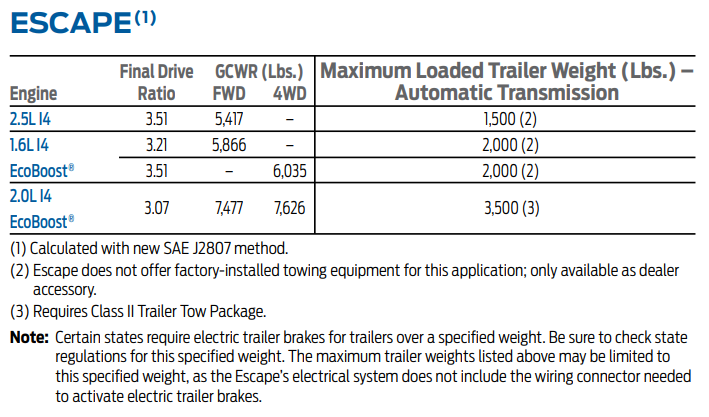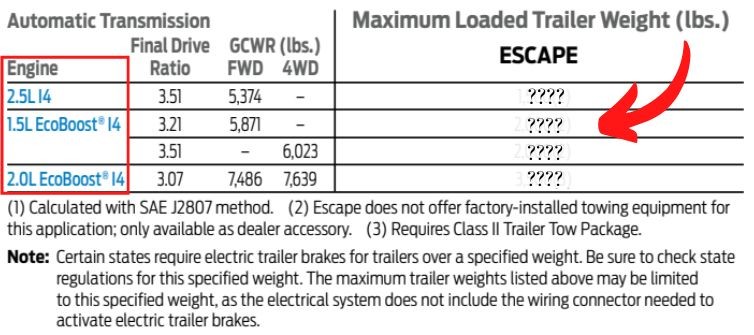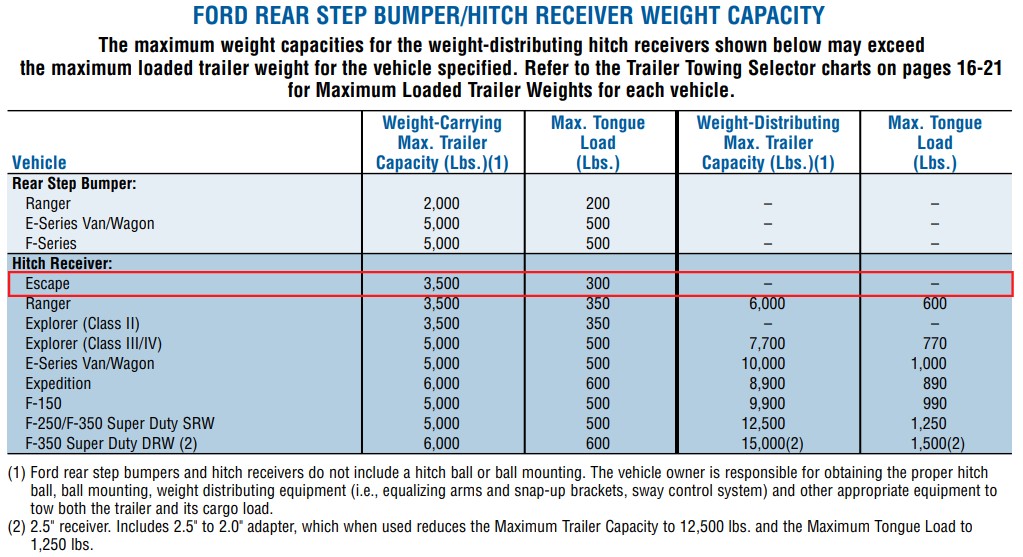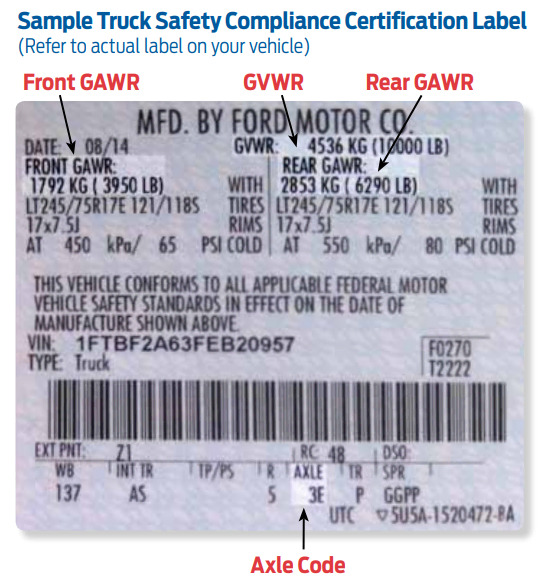The 2013 Ford Escape had a pretty impressive towing capacity after looking into the data and to be honest, the 2013 models were very similar to the 2014- 2017 models, as they shared a lot of the same data because of the fact that they had the same three engine options available to all of these model years.
The engine that you had equipped in your vehicle really played a huge role regarding how much your maximum trailer weight ratings were set at because on the high end, these vehicles were able to pull up to 3,500 pounds but on the low end they had just a mere 1,500 pound rating, so you really do need to look at the data to see where your specific vehicle lies.
Your owner's manual is definitely the best resource you have for your vehicle and contains so much information about it. I recommend that you read through it and that you follow all of Ford's recommendations.
2013 Escape Overview
Overall Capacity: The overall towing capacity for the 2013 Ford Escape ranged from 1,500-3,500 pounds and was solely dependent on the engine option that came equipped in your vehicle. This was by far the largest factor that affected the capacity numbers, although there were other factors that contributed as well, but not on the scale that the engine did.
Capacity By Trim Levels: The 2013 escape had four different trim levels that were available and I went ahead and decided to compare these four trim levels against each other to see if there was any variation in the capacity ratings and in fact, there was.
Each trim level had different engine options that were available to them and that is why we get the different capacity metrics that you see below. The S trim level was able to achieve up to a 1,500 pound rating, while the SE and SEL trim levels were able to achieve a capacity range of between 2,000-3,500 pounds. The Titanium trim levels had the 2.0 liter engine equipped as a standard option, so they had a maximum capacity of up to 3,500 pounds.
- S:1,500 lbs.
- SE: 2,000-3,500 lbs.
- SEL: 2,000-3,500 lbs.
- Titanium: 3,500 lbs.
By Engine Options: Moving on down to the three different engine options that were available for these vehicles, we can see what engines were available for each trim level and this is how I got my data for the above comparison.
The 2.5 liter was the weakest engine option, having a maximum capacity of 1,500 pounds and the 1.6 liter engine had a slightly higher maximum capacity rating of up to 2,000 pounds while the 2.0 liter engine had that 2,000-3,500 pound range.
The 2013 models shared the same three engine options as the 2014-2016 models and most of their specifications as well, besides maybe a few features and weight differences. Since this was true, I couldn't help but notice that the 2016 Escape's towing capacity was the same as the 2015 models and the 2014 models.
- 2.5L (4 cylinder): 1,500 lbs.
- 1.6L (4 cylinder) EcoBoost: 2,000 lbs.
- 2.0L (4 cylinder) EcoBoost: 2,000-3,500 lbs. (2,000 lb. limit without trailer package 536)
The Tow Chart:
Moving on to the tow chart, we can see that it looks very similar to a lot of other model years, especially the 2014-2017 models as most of the data was very similar and the maximum trailer weight ratings, along with the engine options were the same for all model years.
The layout was still the same, having the engine options listed on the left side and the maximum trailer weight ratings listed on the right side, with the axle ratios and gross combined weight ratings sandwiched in the middle of those two columns. Next to the maximum trailer weight ratings, we have notes that are indicated below the table, and I recommend that you read those because they are important pieces of the puzzle too.
The 2013 model's tow chart shared the exact same specifications with the 2014 Escape, as well as the 2015 Escape and by exact, I mean the trailer weight ratings, the GCWR, the axle ratios and even the engine options.


What You Need To Know About Your SUV To Get Your Maximum Trailer Rating:
In all honesty, you only needed to know what engine was equipped in your vehicle from the factory in order to get an accurate trailer weight rating for your vehicle. This is really the only variable that affected the weight ratings in the chart, along with maybe the optional trailer package that was available for the 2.0 liter engines, which is what decided that capacity range of 2,000-3,500 pounds. You were only able to achieve that higher rating if you had this package installed on your vehicle.

- The engine you had equipped - You need to verify whether you have the 2.5 liter engine equipped on your vehicle or if you have the 1.6 liter or 2.0 liter engine equipped instead.
Most of the time you can lift the hood of your vehicle and look in the engine bay and accurately identify what engine is sitting there. Sometimes, though, that is not always possible and finding out what engine you were looking at is hard to figure out and if you find yourself in that position, then I recommend that you use the VIN of your vehicle in order to get the information that you need.
All you need to do is grab the VIN and plug it into an online VIN decoder and it will tell you what engine you have, along with a bunch of other stuff that will come in handy. I personally have had good success with this website and it is dedicated to Ford vehicles, so it works pretty well.
2013 Escape Trailer Tow Packages...
There was a tow package available for these vehicles, like I mentioned earlier and this was referred to as the 536 package and it doesn't come with a lot of equipment, in fact you can see the three items that it does come with listed in the chart below. I outlined the sections that concerned the Escape and this includes the hitch receiver (of course) a wiring harness for connecting your trailer lights (4 pin) and a sway control feature.

Hitch Receiver Weight Limits: I also included a hitch receiver weight capacity chart that I found and even though it doesn't really apply to these specific vehicles it was listed in the guide and I wanted to be as thorough as possible and decided to go ahead and throw it in this article.
This is basically referring to your maximum hitch receiver weight limits for a standard weight carrying hitch and a weight distributing hitch, but it's geared more towards vehicles that have a higher capacity rating.

Trailer Brakes: If you happen to have a model that had the 1.6 liter or 2.0 liter engine equipped then you had a 2,000 to 3,500 pound capacity limit and Ford requires that any trailers that weigh 1,500 pounds or more (which includes the weight of the trailer and all of the cargo in the trailer) have its own trailer brakes installed.
This is the amount of weight that Ford requires you to have trailer brakes, but these requirements may be different for your local state vehicle codes, so you will need to check those out to make sure you are complying with those codes as well.
I also want to note that the 2013 Escape, like a lot of the other model years are not equipped (electrically) to handle electric trailer brakes which means that hooking up a trailer brake controller and a 7 pin wiring harness instead of a four pin wiring harness will be harder than normal to do because the vehicle does not have those required harnesses installed.
You will have to have a shop do this for you or take this task on yourself in order to install these two items, which are a necessity when it comes to electric trailer brakes.

Now The Certification Label...

GVWR & GAWRs: If you want to know your vehicle's gross vehicle weight rating or the gross axle weight rating then you will have to actually do a little bit of digging in order to find this information, but it is not located in the owner's manual or any of the other online resources and is in fact located on the vehicle itself. This information is posted on the safety certification label which is a label that looks like the image that I have shown above and you can find this label on the door pillar of your vehicle, the driver side specifically.
GCWR: The gross combined weight rating metrics were actually specified in the charts that I have posted at the top of this article, so you won't have to go look for these figures because they are included right alongside the maximum trailer weight ratings.
Axle Code: At the bottom of the safety certification label, towards the center of the label you will find an axle code and this corresponds to the rear axle of your vehicle and identifies what axle ratio you have equipped. This is just good information to have just in case and you really don't need it to figure out the axle ratio of your vehicle in order to get the maximum trailer weight rating, I just thought I would mention it.
Helpful Resources I Used For My Research:
I went ahead and listed the three different resources I used when looking up the information for this article and posted them below as a quick reference. These came in really handy and provided me all of the necessary information I needed for these SUVs and are worth checking out.
Last updated on May 12th, 2022 at 07:40 pm
